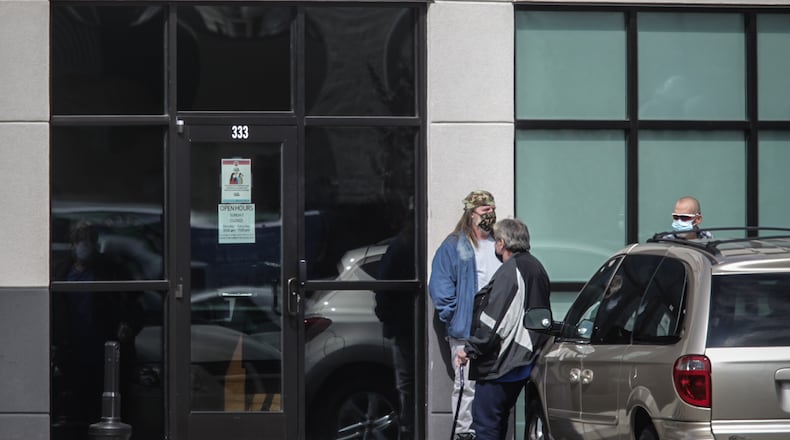A 16-county region that includes Montgomery County could gain 17 new dispensaries based on the state’s updated method that allocates one for every 1,200 patients within each of the 31 Ohio Medical Marijuana Control Program dispensary districts.
The new method was created “with the intent of creating equal access across all of the districts,” said Sharon Maerten-Moore, the Board of Pharmacy’s director of medical marijuana operations.
Under the new allocation, Montgomery County could get four new dispensaries to add to the three it has now. Southwest District 3, which includes Miami County along with Logan and Shelby counties, currently has no dispensary but would gain two under the new plan approved unanimously by the state board.
The district including Warren County would jump from just one to potentially seven dispensaries. Butler, Darke and Preble counties, which comprise Southwest District 2, could see three new dispensaries for a total of five. The districts which include Clark and Greene counties would each rise from two to three dispensaries.
The state has “far, far exceeded” the 12,000 to 24,000 medical marijuana patients projected during the first two years of the program that opened in April of 2019, Maerten-Moore said.
At the end of February, the program had 176,000 patients with roughly 7,500 new patients being added each month, according to Ohio Medical Marijuana Control Program records.
“We are adding patients at a very quick clip,” Maerten-Moore said.
Callahan said the ability to purchase medical marijuana was a “blessing” but she often must make the rounds to far-flung dispensaries — from Dayton to Springfield to Monroe — in order to find the edibles in stock that allow her to function and maintain a job.
“I have to float between three dispensaries because they’re not all consistent on their products yet,” she said.
Region's medical marijuana dispensaries could more than double
A 16-county region that includes Montgomery County could gain 17 new medical marijuana dispensaries under a measure passed by the Ohio Board of Pharmacy. A new allocation method based on 1,200 patients per dispensary per district would allow a total of 27 in the region.
| Region/District | Counties | Current patients per district | New dispensaries | New total |
|---|---|---|---|---|
| Southwest District 2 | Butler, Darke, Preble | 5,817 | 3 | 5 |
| Southwest District 3 | Logan, Miami, Shelby | 2,288 | 2 | 2 |
| Southwest District 4 | Montgomery | 8,389 | 4 | 7 |
| Southwest District 5 | Clermont, Clinton, Warren | 7,245 | 6 | 7 |
| Southwest District 7 | Fayette, Greene, Madison | 2,858 | 1 | 3 |
| Southwest District 8 | Champaign, Clark, Union | 2,989 | 1 | 3 |
Source: State of Ohio Board of Pharmacy
Ohio patients can get a medical marijuana recommendation from a certified doctor to treat more than 20 qualifying medical conditions, including Alzheimer’s disease, chronic pain, fibromyalgia, Parkinson’s disease and post-traumatic stress disorder.
As of March 20, the program’s total product sales reached $344 million on 40,475 pounds of plant material and more than 3.1 million units of manufactured product. Average plant cost was $30.46 for 1/10th of an ounce while manufactured sales averaged $42.69 per unit, according to program statistics.
Maerten-Moore said survey results showed patients fall out of the program primarily due to distance from dispensaries and the cost of products.
“If additional dispensaries are added that and patient travel decreases and due to more competition in the market, hopefully that prices will continue to decrease over time,” she said.
Provisional licenses for the 73 new dispensaries will be granted via a lottery, which worries some dispensary operators like Larry Pegram, president of Pure Ohio Wellness which operates dispensaries in Dayton and Springfield.
“It’s a little concerning that it’s going to be a lottery system,” he said. “I would expect that anyone would want to get their medical products from the highest-scoring applicants, not just picked out of a hat.”
While the system for awarding the next round of provisional licenses is still being developed, requirements for security and standards will be similar to those used to approve the first 57 dispensaries, of which currently 52 are operational, Maerten-Moore said.
Credit: Bill Lackey
Credit: Bill Lackey
Matt Close, executive director of the Ohio Medical Cannabis Industry Association, said the group asked the state to add 100 dispensaries. While the increase approved this week is beneficial, it might come up short faster than expected, he said.
“I believe my members think this is fair and the distribution is positive,” he said. “We just want to make sure going forward as we grow at 7,500 a month patients that they’re able to be quick and nimble in terms of adding more.”
About the Author


